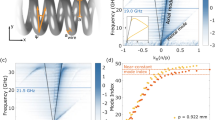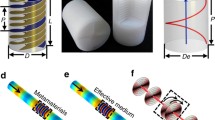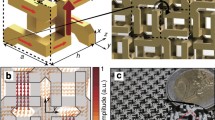Abstract
A novel technique of broadbanding a helical slow-wave structure through negative dispersion shaping is proposed. The model considers a simple continuous chiral dielectric support for the helix inside a metallic barrel, unlike conventional helix slow-wave structures with three discrete dielectric supports at 1200 apart. The dispersion relation of the slow-wave structure was derived following sheath-helix abstraction, suitably benchmarked for special cases, and was used for analyzing the dispersion behavior of a typical slow-wave structure. Chiral dielectric loading could easily provide negative dispersion characteristics (required for broadband operation) by merely controlling the chirality parameter alone. The scheme with its simple geometric configuration is expected to be useful for millimeter-wave devices providing better thermal management.


Similar content being viewed by others
Abbreviations
- SWS:
-
Slow-wave structure
- TWT:
-
Traveling-wave tube
References
A. S. Gilmour, Jr., Principles of Traveling Wave Tubes, (Artech House, Norwood, 1994).
B. N. Basu, Electromagnetic Theory and Applications in Beam-Wave Electronics, (World Scientific, Singapore, 1996).
P. K. Jain, and B. N. Basu, “Electromagnetic Wave Propagation Through Helical Structures,” a contributed chapter in Electromagnetic Fields in Unconventional Materials and Structures, Edited by O. N. Singh and A. Lakhtakia, (John Wiley & Sons Inc., 2000).
I. V. Lindell, A. H. Shivola, S. A. Tretyakov, and A. J. Viitanen, Electromagnetic Waves in Chiral and BI-Isotropic Media, (Artech House, Norwood, 1994).
P. Pelet, and N. Enghetta, “The theory of chirowaveguides,” IEEE Trans. Antennas & Propag. 38, 90–98 (1990).
N. Enghetta, D. L. Jaggard, and M. W. Kowarz, “Electromagnetic waves in Faraday chiral media,” IEEE Trans. Antennas & Propag. 40, 367–374 (1992).
S. K. Datta, E. V. Jayashree, S. D. Veena, and Lalit Kumar, “Broadbanding of a Helical Slow-Wave Structure Using Chiral Dielectric Loading,” Proceedings of the IEEE Intl. Conference on Infrared and Millimeter Waves, California, 22–26 September 2002.
V. K. Varadan, V. V. Varadan, and A. Lakhtakia, “On the possibility of designing broadband anti-reflection coatings with chiral composites,” J. Wave Mater. Interac. 2(1), 71–81 (1987).
L. Winslow, “Phase velocity dispersion shaping as a design parameter in traveling-wave tubes,” IEDM Technical Digest, 350A–350C (1977).
S. K. Datta, S. U. M. Reddy, P. K. Jain and B. N. Basu, “Nonlinear Eulerian analysis of harmonic generation in traveling-wave tubes,” Int. J. Infrared Millim. Waves 20(3) (1999) March.
S. K. Datta, P. K. Jain, M. D. Rajnarayan, and B. N. Basu, “Eulerian analysis for harmonic generation and its control in a helix travelling-wave tube,” Int. J. Electron. 85, 377–395 (1998).
S. K. Datta, P. K. Jain, M. D. Rajnarayan, and B. N. Basu, “Nonlinear Eulerian analysis of helix traveling-wave tubes for harmonic generation and its control,” IEEE Transactions on Electron Devices 46, 420–426 (1999).
S. K. Datta, P. K. Jain, M. D. Rajnarayan, and B. N. Basu, “A simple Eulerian analysis of IM3 distortion in helix traveling-wave tubes,” Microw. Opt. Technol. Lett. 22, 405–408 (1999).
S. K. Datta, P. K. Jain, and B. N. Basu, “Harmonic injection effects in backed-off helix travelling-wave tubes —a study by Eulerian analysis,” Int. J. Electron. 87, 89-97 (2000).
S. K. Datta, and B. N. Basu, “Control of IM3 distortion in helix TWTs by harmonic injection —an Eulerian hydrodynamical study,” IEEE Transactions on Electron Devices 48, 62–67 (2001).
Acknowledgments
The authors would like to thank Prof. B. N. Basu for many valuable suggestions to improve the work. Authors are also thankful to Mr. S. Umamaheshwara Reddy, and Mr. P. Raja Ramana Rao for their support and encouragement during the course of the work. The authors have no words to thank the reviewer, who has aptly pointed out a few mistakes and given many valuable suggestions to improve the work.
Author information
Authors and Affiliations
Corresponding author
Additional information
The basic concept was presented as a conference abstract at the 27th IEEE International Conference on Infrared and Millimeter Waves, California, 22–26 September 2002, as:
S. K. Datta, E. V. Jayashree, S. D. Veena, and Lalit Kumar, “Broadbanding of a Helical Slow-Wave Structure Using Chiral Dielectric Loading.”
Appendix
Appendix
In region-II, the propagation is characterized by the chiral constitutive relations, in which the electric and magnetic fields are coupled through the chirality parameter, given, following the notations of Lindell et al. [4], as:
Here, ɛ and μ are the permittivity and permeability of the medium, respectively, and κ is the chirality parameter. Putting these constitutive relations in source free Maxwell’s equations, one may easily get the Helmholtz’s equations in terms of the decomposed longitudinal electric field given as:
with \( k_{ \pm } = k_{0} n{\left( {1 \pm \kappa } \right)} \) being the axial wave numbers of the two circularly polarized waves, n being the refractive index of the medium, and \( k_{0} = \omega {\sqrt {\varepsilon _{0} \mu _{0} } } \) the free space propagation contrast. The total solutions of the longitudinal components of the electric and magnetic fields are given as:
where E z+ and E z- are the solutions of (A2), and for slow-wave propagation with azimuthal symmetry are expressed as:
Here, we have considered the slow-wave assumption of transverse propagation constants in both region-I and region-II being same as that of γ. This is viable under slow-wave assumption, where the axial wave-numbers corresponding to unbounded waves (k ±) are very small compared to the axial phase-propagation constant β of the guided slow-wave. Here, \(\gamma = {\sqrt {\beta ^{2} - k^{2}_{ \pm } } }\); A2, B2, C2, and D2 are constants to be evaluated by enforcing the boundary conditions. The relations between the other field components for azimuthally symmetric propagating modes are given as:
The required field components in region-II may now be given with the help of the equations (A3), (A4) and (A5) as:
These field components are reproduced in (2), which have been subsequently used in the analysis.
Rights and permissions
About this article
Cite this article
Datta, S.K., Jayashree, E.V., Veena, S.D. et al. Analysis of a Chiral Dielectric Supported Broadband Helix Slow-Wave Structure for Millimeter-Wave TWTs. Int J Infrared Milli Waves 28, 779–787 (2007). https://doi.org/10.1007/s10762-007-9260-6
Received:
Accepted:
Published:
Issue Date:
DOI: https://doi.org/10.1007/s10762-007-9260-6




